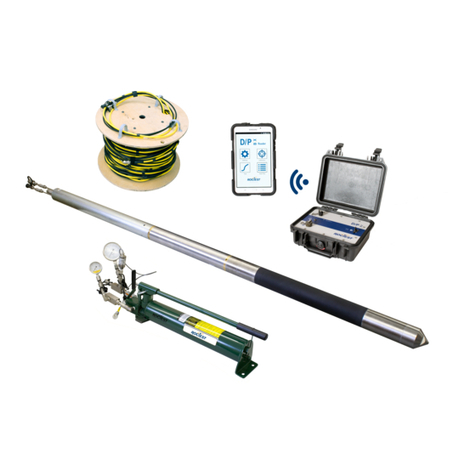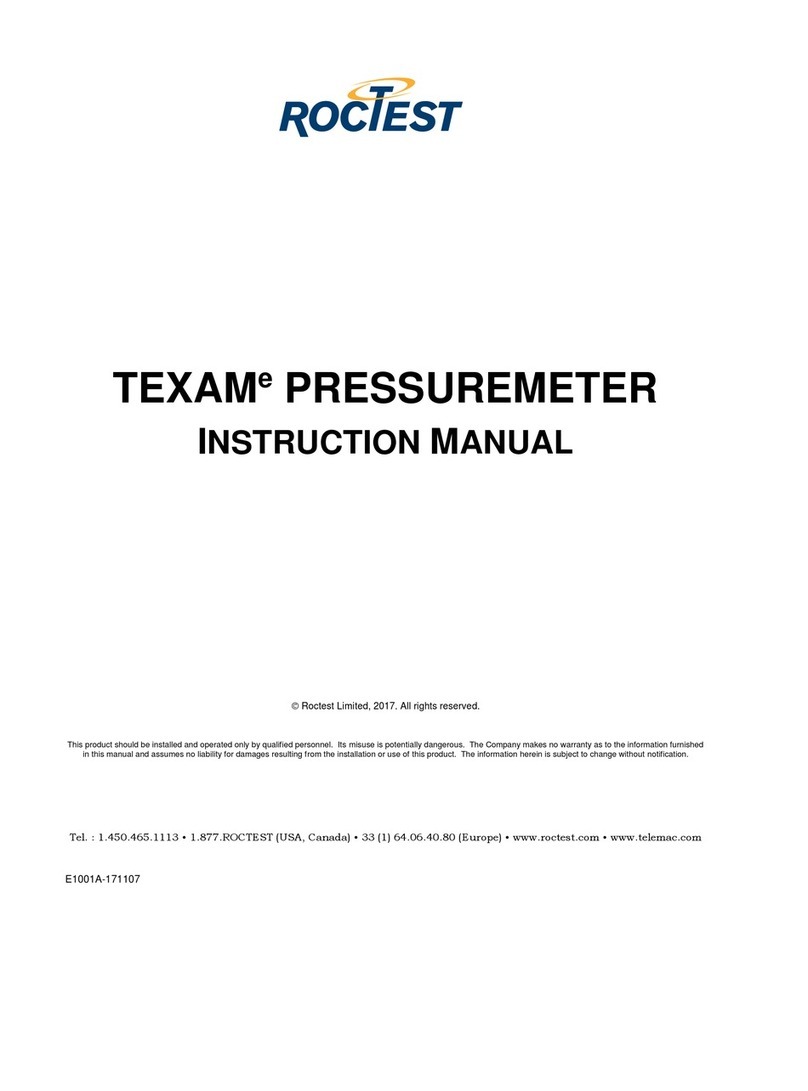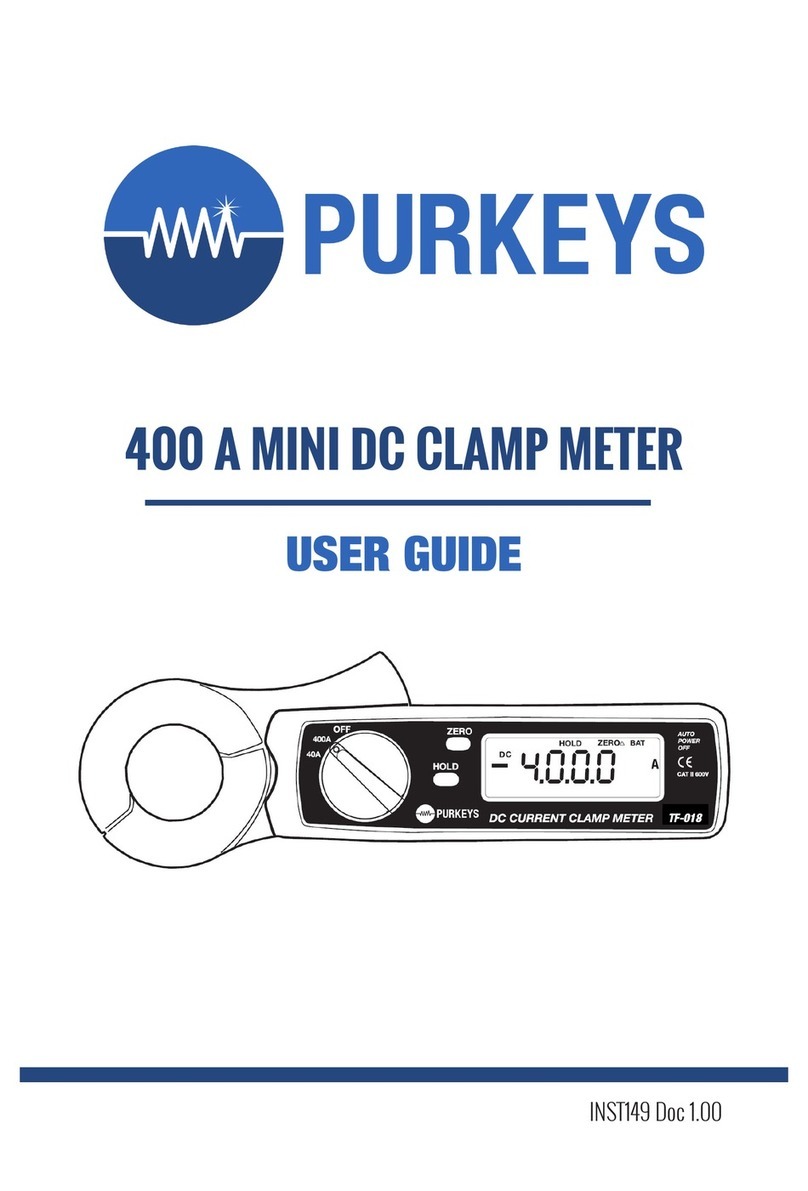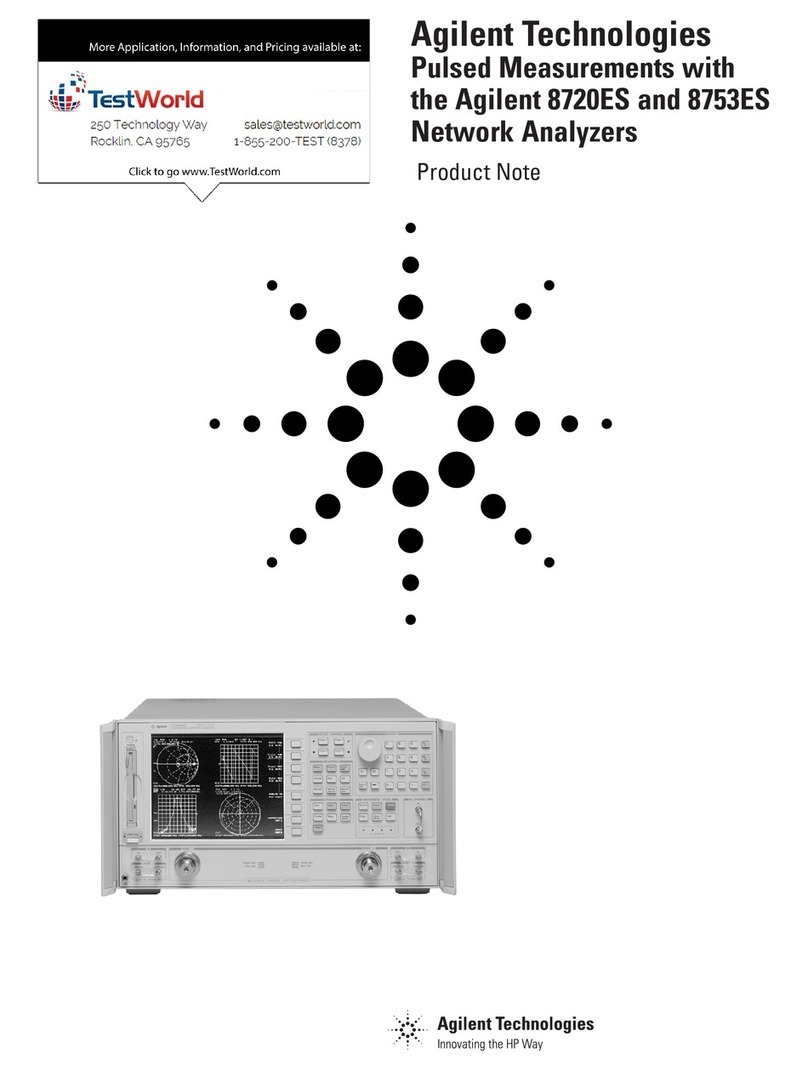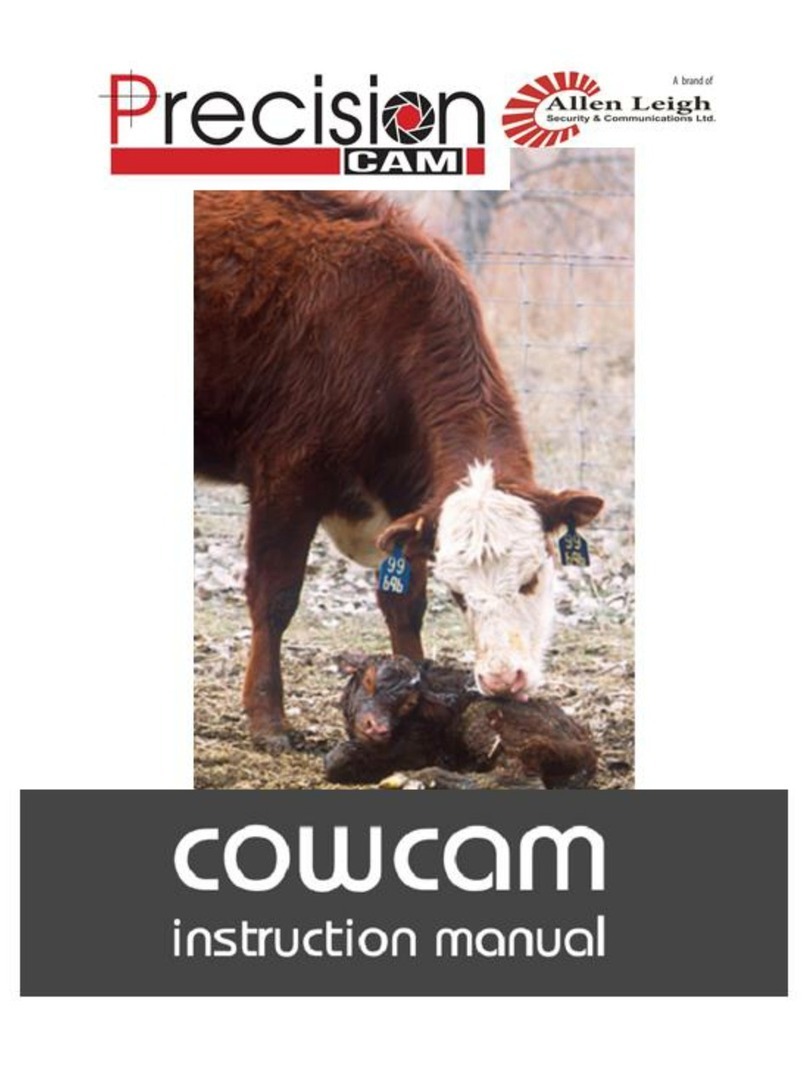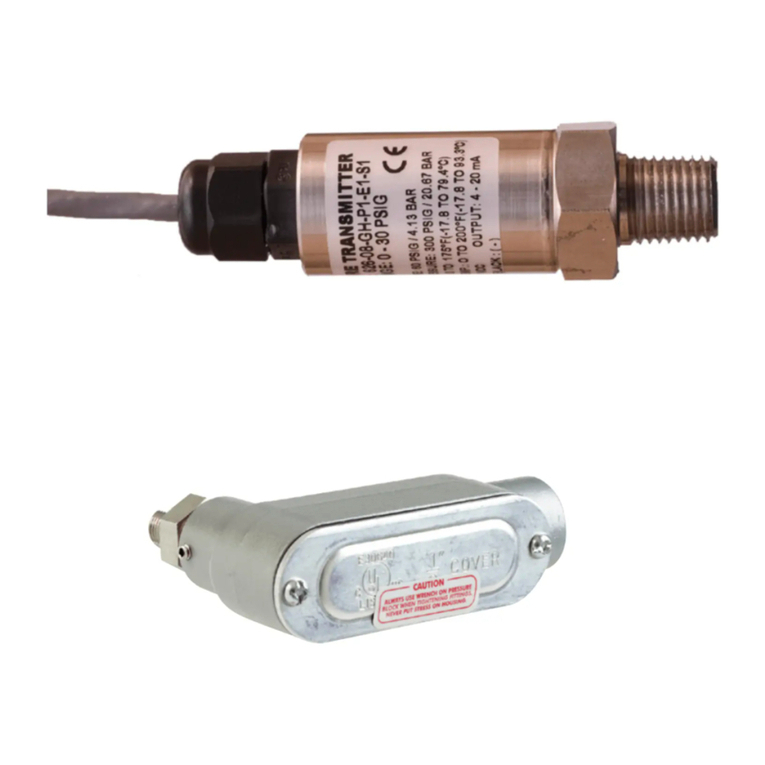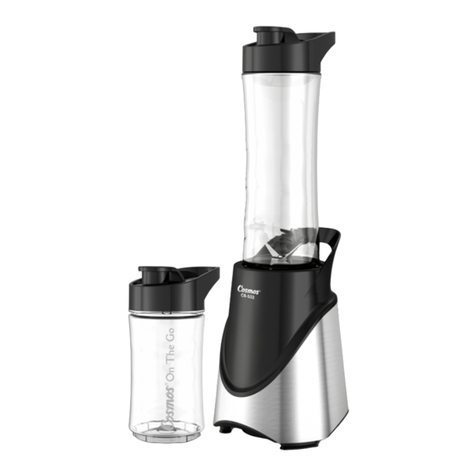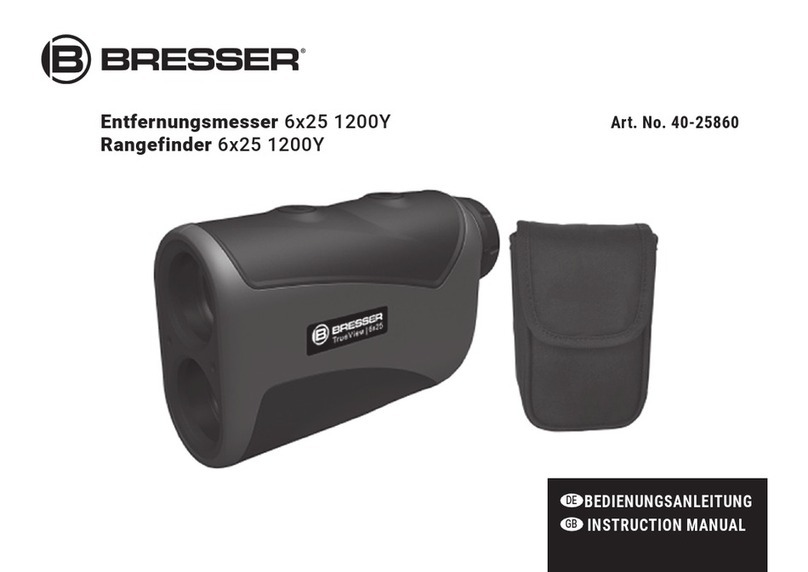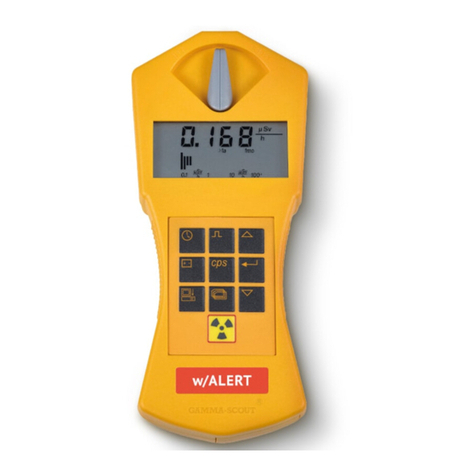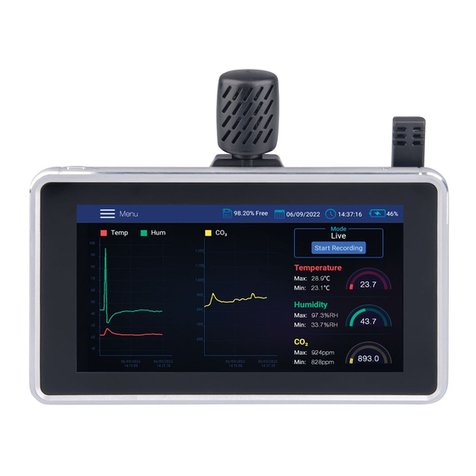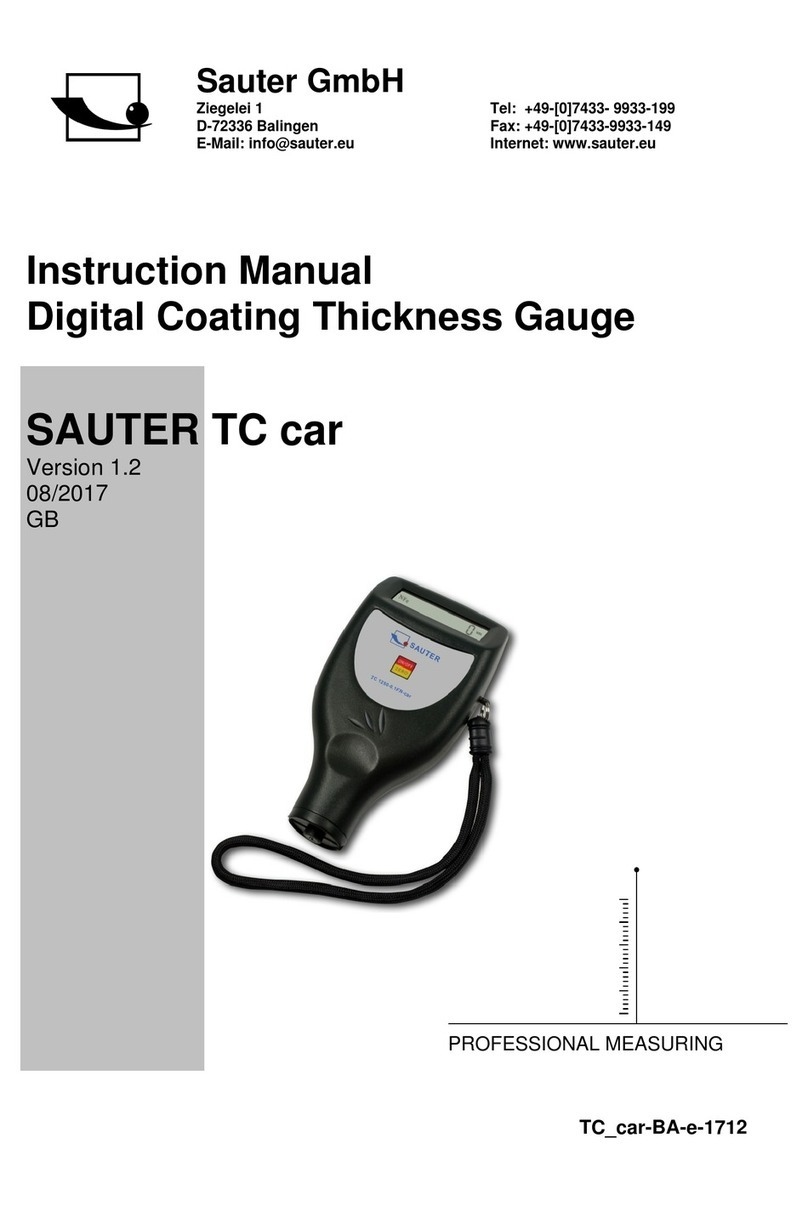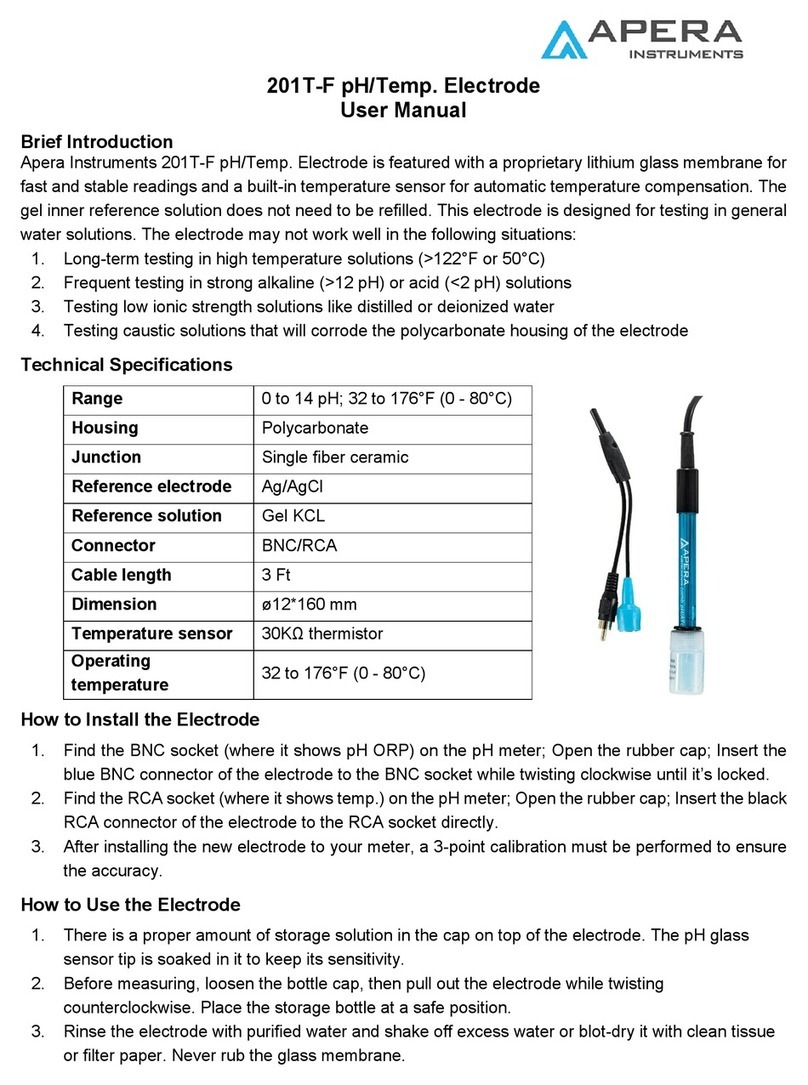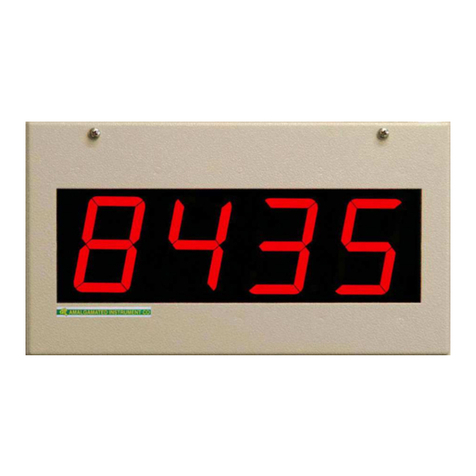ROCTEST PW Series User manual

INSTRUCTION MANUAL
VIBRATING WIRE PIEZOMETER
Model PW
Roctest Limited, 2012. All rights reserved.
This product should be installed and operated only by qualified personnel. Its misuse is potentially dangerous. The Company makes no warranty as to the information furnished
in this manual and assumes no liability for damages resulting from the installation or use of this product. The information herein is subject to change without notification.
Tel.: 1.450.465.1113 • 1.877.ROCTEST (Canada, USA) • 33.1.64.06.40.80 (France) • 41.91.610.1800 (Switzerland)
www.roctest-group.com
E1100D-120118

i
TABLE OF CONTENTS
1APPLICATIONS ........................................................................................................ 1
2PRODUCT ................................................................................................................. 1
2.1General description............................................................................................. 1
2.2Description details and specific uses.................................................................. 1
2.2.1Model PWS and PWC ................................................................................. 1
2.2.2Model PWF.................................................................................................. 2
2.2.3Model PWP.................................................................................................. 2
2.2.4Model PWL .................................................................................................. 3
2.2.5Multi-level piezometer.................................................................................. 3
2.2.6Filter types ................................................................................................... 3
2.3Operation principle.............................................................................................. 4
2.4Calibration........................................................................................................... 5
3INSTALLATION PROCEDURE................................................................................. 5
3.1Pre-installation acceptance reading.................................................................... 5
3.2Filter installation.................................................................................................. 6
3.2.1Low air entry sintered stainless steel filter................................................... 6
3.2.2High air entry ceramic filter.......................................................................... 6
3.3Initial reading ...................................................................................................... 7
3.4On site calibration check (optional)..................................................................... 8
3.5Sensor installation .............................................................................................. 9
3.5.1Installation in fill ........................................................................................... 9
3.5.2Installation in borehole............................................................................... 10
3.5.3Piezometers driven in soft ground ............................................................. 12
3.5.4Installation of a multi-level piezometer ...................................................... 13
3.6Datum reading .................................................................................................. 14
3.7Cable installation .............................................................................................. 14
3.7.1Cable identification .................................................................................... 14
3.7.2Generalities on cable routing..................................................................... 14
3.7.3Horizontal cable runs................................................................................. 15
3.7.4Vertical cable runs ..................................................................................... 16
3.8Splices .............................................................................................................. 17
3.9Cable wiring ...................................................................................................... 18
3.10Lightning protection .......................................................................................... 18
4READING PROCEDURE ........................................................................................ 19
4.1Generalities....................................................................................................... 19

ii
4.2Taking measurements ...................................................................................... 19
4.3Quick verification of measurements.................................................................. 20
5CONVERSION OF READINGS............................................................................... 20
5.1Pressure value.................................................................................................. 20
5.2Temperature value............................................................................................ 22
5.3Temperature and barometric corrections.......................................................... 22
6TROUBLESHOOTING ............................................................................................ 23
6.1Unstable reading............................................................................................... 23
6.2No reading ........................................................................................................ 24
6.3Temperature troubles ....................................................................................... 24
6.4Other troubles ................................................................................................... 25
7MISCELLANEOUS.................................................................................................. 25
7.1Environmental factors ....................................................................................... 25
7.2Conversion factors............................................................................................ 26

E1100D-120119 PW
Page 1
1 APPLICATIONS
The PW series vibrating wire piezometer is designed to measure pore water or other
fluid pressures. It is used to monitor engineering works such as hydraulic structures
(dams, embankments, land fill dikes…), foundations, retaining walls, excavations,
tunnels, etc.
The vibrating wire technology used inside the PW piezometer provides the necessary
ruggedness, reliability, stability and ease of remote monitoring.
2 PRODUCT
2.1GENERAL DESCRIPTION
The PW piezometer is made from a rigid cylindrical body, enclosing the sensing element.
The later consists in a thin flexible diaphragm where a steel wire is attached. All parts of
the sensor other than the wire are machined from a high-grade stainless steel, selected
for its high yield and corrosion resistance.
A standard internal thermistor allows the measurement of the temperature. The PW
piezometer is also fitted with a surge protector and resists electrical and radio frequency
interferences as determined by tests compliant to IEEE and CEI specifications.
The transducer is fitted with several protections against water intrusion: watertight
connector, potting, watertight feed through header, and o-rings.
2.2DESCRIPTION DETAILS AND SPECIFIC USES
Although the principle of all PW series piezometers is the same, there are some
important differences in their designs to fit with their specific applications.
Moreover, at section 2.2.5 of this manual, you will find the vibrating wire multi-level
piezometer, whixh is perfect for measuring pore pressures at various depths beneath a
single surface location. The time proven design of the PW-series sensors allows them to
be tied to the multi-level piezometer core cable. For more information about the
specifications of the multi-level piezometer, please read the datasheet.
2.2.1 MODEL PWS AND PWC
The PWS piezometer model is designed to be embedded in earth fills and concrete, or
inserted into boreholes and pipes as small as 19 mm (¾”).
It consists of a small diameter cylindrical housing containing a pressure transducer and a
thermistor. The cable output is protected by a cable gland and sealed with an epoxy
compound.

E1100D-120119 PW
Page 2
A filter can be set in the front end of the housing and sealed with an o-ring. With the filter
in place, the diaphragm is protected from solid particles, and senses only the fluid
pressure to be measured. The filter housing is easily removable for calibration and
saturation. It can also be replaced with a pipe-threaded adapter to use the gage as a
pressure transducer (PWC Model).
Figure 1: Model PWS piezometer
2.2.2 MODEL PWF
The PWF piezometer model is a thick wall version of the PWS piezometer for use in
direct burial applications. Similar to the PWS model, a pipe-threaded adapter or a filter
can be set in the front end of its housing.
2.2.3 MODEL PWP
The PWP piezometer model is designed for driving into unconsolidated fine grain
materials such as sand, silt, or clay.
The external housing is a thick walled cylinder fitted with a conical head at one end, and
a male thread adapter at the cable entry, fitting "EW" standard drill rods. Four portholes
above the head hold stainless steel filters. The cable passes through the threaded end,
and may be fed through push rods leading to the surface. The cable entry is sealed with
a cable gland and an epoxy compound to avoid any water penetration into the
piezometer.
Figure 2: Model PWP piezometer

E1100D-120119 PW
Page 3
2.2.4 MODEL PWL
The PWL piezometer model is a low pressure sensor. Similar to the PWS model, a
pipe-threaded adapter or a filter can be set in the front end of its housing.
2.2.5 MULTI-LEVEL PIEZOMETER
The multi-level piezometer provides significant advantages in terms of time, resources
and cost reduction related to installation, while providing quick and reliable reading at
various depths.
Moreover, the multi-level piezometer allows the customer to define sensor spacing along
the readout cable providing precise depth control based on site specific requirements.
Junctions between each piezometer and the main cable are reinforced usinf epoxy resin
for a waterproof and durable seal. You will find information about typical installation in
section 3.5.4.
2.2.6 FILTER TYPES
Two types of filters are available: high air entry ceramic or low air entry sintered stainless
steel filters.
The table below summaries the main differences between the two filter models.

E1100D-120119 PW
Page 4
Stainless steel filter
low air pressure entry
pore diameter: ~50 µm
Ceramic filter
high air pressure entry
pore diameter: ~1 µm
Filter generally used. Filter usually installed for use in
unsaturated fine grain material.
Does not allow suction measurements.
If water level drops below the piezometer
and that a suction builds up, the filter can
de-saturate. But as soon as the water level
comes up, it will re-saturate easily.
Allow measuring suction to -100 kPa.
If negative pressure is more important, the
filter will de-saturate and readings will
become incorrect.
Air entry pressure: ~10 kPa Air entry pressure: ~450 kPa
Small time lag. More important time lag.
Easy to saturate and install. Need to be saturated under vacuum.
Allows fine grain infiltration. Helps prevent fine grain infiltration.
Table 1: Differences between filter models
Saturation of the filter is necessary to ensure hydraulic continuity between the
piezometer diaphragm and the pore water in unsaturated soils. It reduces the possibility
of filter clogging and also decreases response time.
2.3OPERATION PRINCIPLE
The sensing element of the pressure transducer is a piano wire attached to a diaphragm.
The latter is in contact with the fluid around and a pressure variation change the
diaphragm position, affecting the wire tension. The tension is directly proportional to the
square of the resonant or natural frequency of the wire.
In operation, plucking voltages are applied to a coil and a magnet located near the wire
in a spectrum of frequencies, spanning the natural wire frequency, thus forcing the wire
into vibration. The oscillation of the wire generates a voltage in the coil. This signal is
amplified by the readout unit, which also discriminates against harmonic frequencies, to
determine the resonant frequency of the wire.

E1100D-120119 PW
Page 5
The relationship between the period Nand the strain in the vibrating wire is expressed
by the following equation:
2
9
10
N
K
where = strain in micro-strain
N= vibration period in microseconds
K= gage constant, specific for each type of gage
The vibrating wire technology offers the unique advantage of a frequency output signal
virtually unaffected by line impedance, or contact resistance. Cable length of several
kilometres can be used without signal deterioration.
A portable unit as the MB-3TL (or MB-6T(L)) can be used to read vibrating wire sensors. It
proceeds to all necessary operations: wire excitation, signal conditioning and reading
display. Contact Roctest – Telemac for further information.
2.4CALIBRATION
A calibration data sheet is supplied with each sensor. It enables conversion of gross
readings into pressure values and temperature correction.
All the sensors are individually calibrated over their working range before shipment. The
calibration factors and the thermal coefficient are established by running the calibration
data points through a linear or polynomial regression formula.
During the calibration process, the sensors undergo a mechanical cycling and are tested
at 40 degrees Celsius.
3 INSTALLATION PROCEDURE
3.1PRE-INSTALLATION ACCEPTANCE READING
Reading of all instruments should be taken as the piezometers are received to ensure
they have not been damaged during shipment or handling on site.
Take a reading in linear units with the piezometer in air, without any filter and in the
same position in which it is to be installed. Then compare it with the factory reading
shown on the calibration sheet. The difference should not be more than twenty linear
units. It can come from hits or vibrations during the shipment and/or from the fact that
temperature and barometric pressure on site are certainly different than those at the
factory, during calibration process. However, this has no effect on the linearity of the
sensor.
Take also a reading of the temperature gage to be sure the thermistor is working properly.

E1100D-120119 PW
Page 6
For details about how to take readings or how to convert frequency into linear units, please
refer to chapter 4 page 19 (Reading Procedure).
3.2FILTER INSTALLATION
3.2.1 LOW AIR ENTRY SINTERED STAINLESS STEEL FILTER
The filter is shipped already mounted on the piezometer body. It should be removed by
holding the piezometer in one hand, pulling, and twisting the filter housing with the other
hand.
Note:The filter on a PWP piezometer is removed by unscrewing the conical head.
Immerse the filter and the piezometer pointing upwards in clean water for approximately
fifteen minutes. De-aired water can be used (water may be de-aired by boiling it for a few
minutes or by applying a vacuum). Tap piezometer housing lightly to remove any air
bubbles present.
Reassemble the filter working underwater. For lower pressure range transducers, while
pushing on the filter assembly, check the readings on the readout unit to avoid pressure
variations that exceed the piezometer range and then can damage the sensor.
As soon as the filter is saturated, it must stay submerged until installation.
3.2.2 HIGH AIR ENTRY CERAMIC FILTER
The filter is delivered cased in a metallic housing and pre-saturated in water. Final
installation must be carried out under water to avoid any air intrusion.
Connect the piezometer to a readout unit.
Put the piezometer upside-down in a container filled with clean water. The
piezometer tip should be up and completely submerged.
With the piezometer submerged, firmly grasp the housing with both hands and
push the filter assembly into its tip. Gradually increase the pushing force using
thumbs until it is fully inserted. This step may take a while to be completed.
Some resistance will be met; it is normal and due to the small porosity of the
ceramic filter. While pushing on the filter assembly, check the readings on the
readout unit to avoid excessive pressure variations that could damage the
piezometer. Refer to the calibration sheet for pressure range.
The filter installation is now completed.
Keep the piezometer underwater for at least 24 hours before proceeding with
field installation. This will allow the pressure induced by the filter installation to
decrease. When ready to be installed, the piezometer reading should be close to
the one of acceptance test with the filter removed (see detail in section on initial

E1100D-120119 PW
Page 7
reading).
3.3 INITIAL READING
Before installing the piezometer in its final location on site, an initial reading has to be
taken to correctly convert readings in linear units into pressure measurements when the
piezometer is in operation. This process is also necessary to be able to apply later
temperature and barometric corrections.
Leave the instrument in water for two or three hours for the temperature to stabilize. It is
preferable to leave it overnight provided that arrangements are made to keep the water
at more or less uniform temperature. All sudden changes of temperature and exposure
to the sun must be avoided.
With the water temperature, ambient temperature and piezometer temperature in
equilibrium, raise the piezometer by the electrical cable until it is out of the water except
two centimetres. Take three successive readings to ensure a stable value and record it.
This is the initial reading (called L0). Record ambient temperature (T0) and barometric
pressure (S0).
Compare readings in linear units before and after the filter installation. They should be
close. A small difference on raw readings comes from the fact that temperature and
barometric pressure may have changed in the meantime. A difference of more than ten
linear units may indicate that the filter is not correctly saturated or the pressure induced
during its installation is not dissipated yet.
For details about how to take readings or how to convert frequency into linear units,
please refer to chapter 4 page 19 (Reading Procedure).
A special calculation has to be done if using the polynomial relation to convert raw
readings into pressure measurements. The coefficient C' of the calibration sheet must be
calculated because it depends on temperature and barometric pressure on site, which
are different from those in factory. Use the following relation:
0
2
0BLALC
where: C' = new calibration factor in kilopascal
A,B = calibration factors (see calibration sheet)
L0= initial reading in linear unit

E1100D-120119 PW
Page 8
Figure 3: Summary of the different readings
Note: It is not necessary at this step to apply corrections to pressure calculation, but it is
important to record both temperature and barometric pressure.
3.4ON SITE CALIBRATION CHECK (OPTIONAL)
Piezometers are calibrated in factory with high precision calibrators having an accuracy
at least four times better than the accuracy of the piezometer. However, it is tempting to
make a calibration check on site.
The best method for an on site calibration check is to carry out the readings in a
water-filled pipe at uniform temperature. Variables tough to control, unknown in an open
borehole as temperature gradients, flow or density variations and that were not present
at time of factory calibration are eliminated. A protected calibration check pipe may be
installed in a borehole or in a building.
The calibration check consists in comparing readings got with different water levels in

E1100D-120119 PW
Page 9
the pipe. Barometric pressure should be recorded along with the readings.
Note that when installing a piezometer into a standpipe, the water level raises due to the
volume inserted (piezometer body and cable). This has an effect especially with small
diameter pipes and long cable lengths. Allow sufficient time for the level to equilibrate
before making readings.
3.5SENSOR INSTALLATION
Vibrating wire piezometers are installed in various ways to suit each individual
application. Specific guidelines for the piezometer installation have been set by various
agencies and specialists. Standard methods are explained below.
3.5.1 INSTALLATION IN FILL
3.5.1.1 COMPACTED CLAY
Excavate a trench or recess about 30 cm
deep. Drive a cylindrical hole in the
sidewall of the trench. The diameter hole
should be slightly smaller than the
piezometer’s body.
To make sure that the filter is in direct
contact with the host material to get a
good continuity with the saturated high air
entry filter and the pore water, smear the
filter with a thin paste of the saturated
material. Push the piezometer into the side
of the borehole.

E1100D-120119 PW
Page 10
Before backfilling, the cable must be laid
with the utmost care. Loop the cable
around the recess; make sure it is resting
on a bed of hand placed and compacted
screened clay.
Make sure that the cable does not cross over itself or other cables in the same area.
Keep the cables apart.
Backfill the recess with screened clay containing no particles larger than 2.5 mm in
diameter. The backfill should have a water content and density equal to that of the
surrounding material.
Make sure that the cable is protected from potential damage caused by angular material,
compacting equipment or stretching due to subsequent deformations during construction
or fill placement.
3.5.1.2 GRANULAR MATERIALS
Install the piezometer as described above in a recess excavated for this purpose. Place
the piezometer within the trench, loop cable and backfill with screened material
containing the same moisture content and compacted to the same density as the
surrounding fill.
In rock fill, it is necessary to place a graded filter around the piezometer. Use fine grain,
clean sand around the instrument and increase the particle size as the backfill proceeds
outwards to the rock fill. The sand placed in the recess around the instrument and cable
should range in size from 0.5 mm to 2.5 mm in diameter.
3.5.2 INSTALLATION IN BOREHOLE
The method used to install a piezometer in a borehole depends on the particular
conditions in which the installation must be carried out. Artesian conditions, borehole
stability, available drilling equipment and sealing material are among the factors, which
will influence the method chosen. The method described below will cover most
applications.
The borehole should be drilled without any mud. Therefore, the use of a casing is
sometimes necessary.
1. Drive the casing thirty centimetres below the required piezometer elevation.
Wash until the water emerging from the borehole runs clear. This will prevent the

E1100D-120119 PW
Page 11
backfill materials from sticking to and plugging the casing.
2. Raise the casing fifteen centimetres and pour sand bellow its bottom. Repeat the
operation once and lower the piezometer to the top of the sand. Check the
borehole depth after each operation.
3. While holding the instrument in place, repeat step 2 until thirty centimetres of
sand are placed above the piezometer.
4. Raise the casing fifteen centimetres and pour compressed dry bentonite below its
bottom. Repeat the operation until a seal of at least 1.2 m is in place. During
bentonite placement, keep the cable taut to prevent the bentonite from hooking
up in the casing. Pour the bentonite in the hole slowly to avoid bridging. A brush
or a thirty centimetre layer road salt can be used to unplug a blocked hole. Check
the borehole depth after each operation.
5. Wait for the bentonite to set up. Two hours are generally enough. Refer to
instructions of the supplier for exact time. Keep the borehole filled with water.
This will prevent the bentonite during its setting from drawing water from
surrounding soil.
6. If only one piezometer is to be installed in the hole, backfill the casing with a
bentonite/cement grout.
If more than one piezometer is to be installed in the borehole, backfill with a
bentonite/cement grout to an elevation of one meter and half below the second
piezometer. Then use 1.2 m of bentonite. Repeat operations 1 to 5 for the
second piezometer. When all instruments are installed, backfill with a
bentonite/cement grout.
7. Pull the casing without rotating it during removal. Top off the borehole with grout.
If the deepest piezometer is to measure the pore water pressure in a specific horizon, it
is necessary to drive the casing below the instrument and set a 1.2 m bentonite seal at
the bottom of borehole. Pull the casing as the bentonite is set in place. Proceed by
stages of fifteen centimetres. Be very careful not to plug or allow bentonite to stick to the
inside walls of the casing. This is accomplished by making sure the bentonite level is at
all times below the casing and by slowly dropping bentonite in single file down the hole.
Trying to feed bentonite too rapidly will result in bridging in the casing or borehole.
Tamping of compressed bentonite is not required. Prior to setting the sand in place,
lower a cylindrical weight down the borehole to ensure that it is clear from any
obstructions and if necessary, rinse the borehole until clear water emerges.
Note:It is also possible to place the piezometer into a sand filled canvas bag. The bag
then acts as a sand filled intake zone.

E1100D-120119 PW
Page 12
Figure 4: Typical installation of piezometers in a borehole
Note that an alternate way to install piezometers in boreholes is to fill the entire borehole
with grout after having lowered the instruments. Although this method is promising, there
is presently a lack of feedback from real situations which makes difficult to know its
benefits and its drawbacks.
3.5.3 PIEZOMETERS DRIVEN IN SOFT GROUND
The PWP model is designed to be pushed into place from the surface in soft materials.
For deeper installations where driving from the surface is impossible, the piezometer
may be pushed into place from the bottom of a pre-drilled borehole.
The PWP model piezometer comes fitted with a male EW rod thread that screws directly
onto EW rod.
The rods must form an effective seal above the piezometer. Should other rods be
adapted to push the piezometer in place, it is important that the diameter of the first 1.2
m to 1.5 m of rod remains larger than the outside diameter of the piezometer housing.
The first step of the installation is to lay a sufficient number of rods side by side,
alternating a male thread beside a female thread.

E1100D-120119 PW
Page 13
The piezometer cable is threaded through the rods leaving around fifty centimetre loop
of cable laying flat on the ground each time the cable emerges from one rod and enters
a subsequent rod. Let about seven meters of free cable extends beyond the lower
extremity of the first rod. This should provide sufficient slack to allow easy manipulation
of the rods as they are screwed together and pushed in place.
Figure 5: Preparation before PWP installation
Screw the lower rod onto the piezometer. Use a pipe-sealing compound on the threads
to form a permanent seal, preventing pore water from flowing into the rod string, causing
corresponding pressure drops.
Push the piezometer in place and monitor any pressure build-up at the tip. Should the
pressure exceed the working pressure range, stop the driving and wait until the pressure
dissipates.
It is necessary in soils with high salt content to use a nylon bushing between the
piezometer and the push rods to prevent apparent pore water pressure increases
caused by hydrogen gas generation due to galvanic corrosion, or pressure increases
caused by any electro-osmotic effect on the pore water.
3.5.4 INSTALLATION OF A MULTI-LEVEL PIEZOMETER
The installation of a multi-level piezometer is quick and reliable because multiple
piezometers are connected to a single communication cable, which is in turn connected
to the data acquisition system (SENSLOG) or readout (MB-3TL or MB-6T(L)).
A typical installation of the multi-level piezometer utilizes a direct grouting installation so
that only the multi-level piezometer string and a grout injection tube are needed to
complete the installation. Once the grout has hardened, the piezometers are isolated
from one another, allowing precise measurements of pore water pressure changes at
various depths.

E1100D-120119 PW
Page 14
3.6 DATUM READING
Due to the operations during the installation of the instruments, the pore water pressure
may take time to come back to its natural state. This can take a few hours to a few
weeks, depending of the soil permeability.
After installation, take readings periodically to determine a correct datum reading. It is
obtained when readings become stable over a period of a few days.
3.7CABLE INSTALLATION
3.7.1 CABLE IDENTIFICATION
The signal coming from the sensor is transmitted through an electrical cable which is
generally supplied in rolls.
Cables are identified with the serial number that is labelled on the sensor housing. The
serial number is stamped on a tag that is fastened to the readout end of the cable.
It is very important to clearly identify the instrument for wiring or reading purposes.
In the case where the sensor cable has to be cut or if the cable end is inaccessible, make
sure to be able to identify it (by marking its serial number for instance with an indelible
marker or using a color code). If there are a lot of risks of cuts, the cable should be
marked using metal tags at regular intervals along its entire length.
3.7.2 GENERALITIES ON CABLE ROUTING
Route the cable towards the junction or switching panel. Make sure that the cable is
protected from cuts or abrasion, potential damage caused by angular material,
compacting equipment or stretching due to subsequent deformations during construction
or fill placement.
In embankments, cables may be embedded in a protective covering of sand or selected
fine embankment materials. A typical installation comprises the positioning of a series of
cables on a prepared layer consisting of not less than 20 cm of compacted selected fine
material. The prepared layer may be located either in a trench or on an exposed ramp.
Placement of cables to be embedded in concrete involves positioning and immobilizing
the cables in such a way that damage during concrete placement and vibration is
minimized.
Surface installations require continuous surveillance and protection from the earth moving
equipment circulating on the field.
If necessary, run the cable through rigid or flexible conduits to the terminal location but
be careful to water seepage. To provide protection for cable running over concrete lifts,

E1100D-120119 PW
Page 15
hand placed concrete is sometimes used, depending on site conditions.
During the cable routing, read the instruments at regular intervals to ensure continued
proper functioning.
Check that the cable does not cross over itself or other cables in the same area.
Record the cable routing with care and transfer this routing to the drawings.
3.7.3 HORIZONTAL CABLE RUNS
Some of the more important considerations that must be given to horizontal cable runs
are:
Never excavate a trench straight through the clay core of a dam.
Avoid traversing transition zones where large differential settlements could create
excessive strain in the cable.
Avoid cable splices. If necessary, refer to paragraph 3.8 page 17 (Splices).
Do not lay cables one on top of the other.
Use horizontal snaking or vertical snaking of the cable within the trenches. For
most materials, a pitch of 2 m with amplitude of 40 cm is suitable. In very wet clays
increase the pitch to 1 m. It enhances the elongation capability of the electrical
cable.
Use a combination of horizontal and vertical snaking at transition zones.
In rock fill dams with earth fill cores, it is frequently convenient to install cable in trenches
in the core and fine filter zones, and in ramps in the coarse filter and compacted rock fill
shell zones. Individual cables should be spaced not less than 2 cm apart, and no cable
should be closer than 15 cm to the edge of the prepared layer. In instances in which
cables must be placed in a given array, the cables should be separated from each other
by a vertical interval of not less than 15 cm of selected fine embankment material.
During the backfill of trenches in earth dams, a plug, approximately 60 cm in width, made
of a mixture of 5% bentonite (by volume) from an approved source and exhibiting a free
swell factor of approximately 60%, and 95% embankment material, can be placed in the
trenches at intervals of not greater than 7.5 m. The bentonite plugs reduce the possibility
of water seepage through the embankment core along the backfilled trenches.

E1100D-120119 PW
Page 16
Figure 6: General view of horizontal cable routing
3.7.4 VERTICAL CABLE RUNS
The procedure shown below is an efficient and safe way to route cables from the sensor to
the top of the embankment or of the dam.
Figure 7: Procedure to route vertically cables (continued)

E1100D-120119 PW
Page 17
Figure 7: Procedure to route vertically cables
3.8SPLICES
Generally, cable splices are to be avoided. If necessary, use only the manufacturer’s
approved standard or high-pressure splice kit. Splicing instructions are included with the
splice kit.
Should the cable be cut, we recommend the use of our high pressure cable splice kits,
especially if the splice is located underwater.
Because of the vibrating wire technology the sensor uses, the output signal is a frequency,
not affected by the impedance of the cable. Therefore, splices have no effect on the quality
of the readings.
This manual suits for next models
5
Table of contents
Other ROCTEST Measuring Instrument manuals
